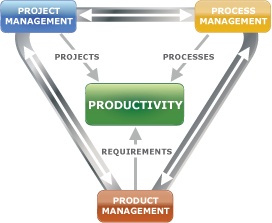“I am at a very early stage in my learning curve of business process management. I know our processes need to be improved, but I really don’t know where to start!” Is this something you are feeling? If so you are certainly not alone. This cry is something we often hear at Triaster and it’s not at all surprising. For organisations new to business process management (BPM) – often from industries such as Government and Education who haven’t traditionally thought of what they do as being business processes, getting started is daunting.
Image sourced from: caba.org.uk
Getting started with BPM
The tendency is to try and learn everything about business process management and to plan out in detail how you are going to capture, manage and improve the processes for the whole organisation - before you get started.
Of course learning and planning are good things, but sometimes the scope of a project is just so wide that you end up trying to do too much at this stage and don’t actually get anything done.
BPM software system choice
Another rabbit hole is software system choice. Which system to invest in is always a hard choice. The investment required is generally significant both in terms of the cost of the system and the time needed to implement it.
Everyone wants to ensure that as many different parts of the organisation buy into the purchase as possible – sometimes to ensure budget sharing and sometimes just to share the responsibility for what is often a highly visible system choice.
Most organisations also need to get IT approval on the purchase.
All this can mean that the evaluation of the software system grows and grows in scope until it involves a number of disparate groups, all with differing objectives and requirements which pushes back the final purchase decision time and time again.
All the while costs are being incurred – in the cost of the time taken to evaluate the system – and no process improvement is being accomplished.
So, what to do?
6 steps to get started with BPM and Process Improvement
Having worked with many hundreds of organisations implementing business process management systems and process improvement, we at Triaster have had the opportunity to see how many different approaches have worked.
What we have seen consistently, is that those who take the following approach achieve the most in the shortest timeframe.
1. Don’t spend too long learning the theory of BPM
Obviously before you get started you have to know something about business process management, but be aware that only so much can be learnt in theory. At a certain point you just have to get started and put the theory into practice.

Image sourced from: watermarklearning.com
It is in the 'doing' where the learning takes place. This is because BPM is not an exact science, there are many theories on how to create and implement a business process improvement strategy and how best to improve your processes. None of them will be an exact fit for your organisation. You will need to take the approach that seems to best fit your objectives and your organisation and adapt it to work for you and your organisation – this will take some trial error and the earlier you get started on this the better.
2. Trial potential BPM software systems as soon as possible
Once you have an idea of what you need your software system to deliver, move forward quickly with a trial of the one that you think most closely matches your requirements. You can’t get a good idea of how any software system really works, without using it.
Most software vendors will offer a trial of their system and even if there is a cost, a return on the investment is achieved by:
- better decision making
- reduced time to making the purchase decision
- moving forward with your BPM and improvement objectives during the trial
With most systems now being delivered via the cloud, there is little need to involve IT and the trial can be up and running in no time at all. This means that you can use the trial to get started on achieving your objectives.
3. Choose your start point wisely
This is where it does pay to spend some time planning.
The start point for any business process improvement project needs to be very narrow in focus. You are trying to get started, you are trialling a new approach, your new project team, new software… so keep the scope tight.
Start with an area of the business which is known (rather than one where the processes are under development) so there are subject matter experts who know what the processes are. The business area should also be:
- Fairly small scale – so not too many people are involved in the project
- Enable you to have a positive impact on the maximum number of people
A really good place to start is with a supporting process such as an HR, Business Operations or Finance process. Supporting processes are usually delivered by a fairly small team, but they impact everyone in the business.
Making even small improvements to one supporting process can benefit nearly everyone in the business and, for example, if a small time saving is made for each employee every week say, that will add up to a big cost saving for the organisation.
4. Eat the elephant one bite at a time

Image sourced from: chrisnierhaus.com
Your software system trial is the first bite of the elephant. Use it to:
- Introduce BPM to your organisation
- Start the communication about what you are trying to achieve and how it will benefit everyone in the organisation (different people will benefit differently, target your communications)
- Show some tangible results to senior management (already!)
- Evaluate the software :
- Does the system show how the processes link end-to end ?
- Can the system capture data in a form that can be globally updated and reported upon?
- Does the system show you a 3D model of your organisation, which will really help you to manage and improve your processes?
Remember that once the software choice is made and the system is purchased – you just need to take the next step (or next bite). Don’t go back to thinking, now I have to do everything!
5. The BPM system might be new, but your processes aren’t
If you have any existing process or policy documentation, think how you can import this into your new system. It is often easier to update old documentation than starting from scratch.
Don’t make the mistake of thinking that out of date information will do the job, but it may well be a good starting point to get subject matter experts involved to review and update process documentation.
6. Get help!

Image sourced from: teamworkandleadership.com
As with almost anything in life those that are most effective at BPM and Business Improvement are those who are most effective at getting other people on-board. So ensure that you have senior management support and are able to get time from the subject matter experts as you need it.
Build a team around you. You may need to build a business case in the early stages, but as soon as you can demonstrate ROI, make sure that you take the time to write the business case for more team members. If salaried roles are too hard to justify, at least ask for consultancy support.
Are you wanting to get started with BPM and Process Improvement?
We hope that you have found this article interesting and that it helps you to get started on achieving your BPM objectives. As mentioned above, it is written from experience of working with many hundreds of organisations to implement BPM and process improvement.
Not all of them have taken the approach set out above, but those that have, have achieved the most in the shortest time and I believe, had the better experience in doing so.
We know that the Triaster software platform won’t suit all organisations. However we can confirm that it does:
- Show how your business processes link end-to end
- Capture data in a form that can be globally updated and reported upon
- Show you a 3D model of your organisation, which will really help you to manage and improve your processes
- And much more besides
If you would like to learn more about the Triaster platform, please either contact us directly or register for one of our webinars.
We really look forward to helping you get started:
Related articles:
How to Improve Business Processes...Before You Know What They Are
Implementing a Business Process Management System: What You Need to Know
Business Management System: 4 Steps to Finding the Right One For You
The Importance of Process Quality
Understanding Business Process Management: A Beginner's Guide
Written by Emma Harris
Emma was Operations Director for Triaster for nearly 20 years, during which time as well as learning and perfecting her BPM and process improvement skills, she honed her inbound marketing expertise. She now runs D2e - Designed to engage - which designs and develops bespoke, engaging, HubSpot CMS websites, that help your entire company to grow and scale. She is delighted to still be delivering Triaster's marketing, whilst also helping other companies turn their websites into their hardest working asset.



